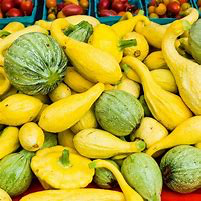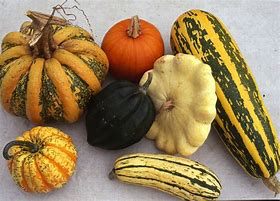“You know, when you get your first asparagus, or your first acorn squash, or your first really good tomato of the season, those are the moments that define the cook's year. I get more excited by that than anything else.” — Mario Batali
There are several kinds of squash grown in the garden:
- Summer squash, including Zucchini

- Winter squash, including acorn, butternut and patty pan

- Pumpkin will also be included in this category since it’s in the same family and has similar characteristics. (Also to note: what you buy as “canned pumpkin” is actually squash. Check out the label.)
Benefits and nutritional information:
- Given the wide range of squash varieties it’s natural that there is an equally wide range of nutritional benefits, varying in levels of calories, fiber, vitamins and minerals.
- Summer squash is considered the healthiest of the varieties.
- Also highly ranked, among the more common varieties, are Butternut, Pumpkin, Acorn and Hubbard.
Starting:
- Since squash seeds germinate best when the soil temperature is at least 70 degrees, best results will be achieved either by buying commercially grown starts or producing your own starts from seeds indoors.
When to plant:
- Setting out squash plants with a soil temperature below 60 degrees can result in less than healthy plants, and may contribute to blossom end rot when they begin to set fruit.
- Like all other seedlings, squash need to be hardened off prior to planting out.
Thinning, training
- Spacing of squash plants depends on the variety; summer squash should be spaced 3 to 4 feet apart while winter squash, which produce longer vines, need 4 to 6 feet.
- Like any other vining plant, squash can be grown on a trellis; however, since some of the varieties can be quite large it’s often necessary to provide support for the fruit.
Signs of over-watering, nutrient deficiency
Pests and pest controls
Harvesting
- Summer squash, zucchini and patty pan squash are best when picked while small, before their skins harden and their cores get pithy and full of seeds.
- Winter squash can be harvested any time after they’ve reached mature size, but they’ll develop more sweetness if left on the vines until the leaves start dying back in the fall.
- Harvesting is best done with a pair of hand pruners, cutting the stem about an inch from the fruit.
- Winter squash are often at their best after 2 to 4 months of storage in a cool, dry and dark place with good air drainage.
